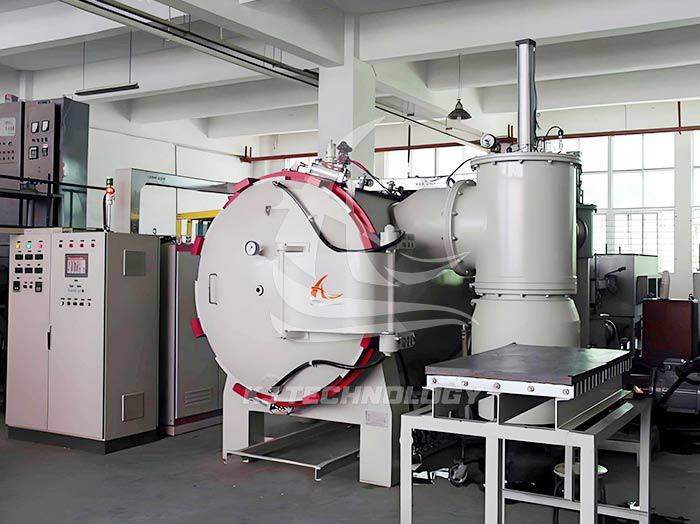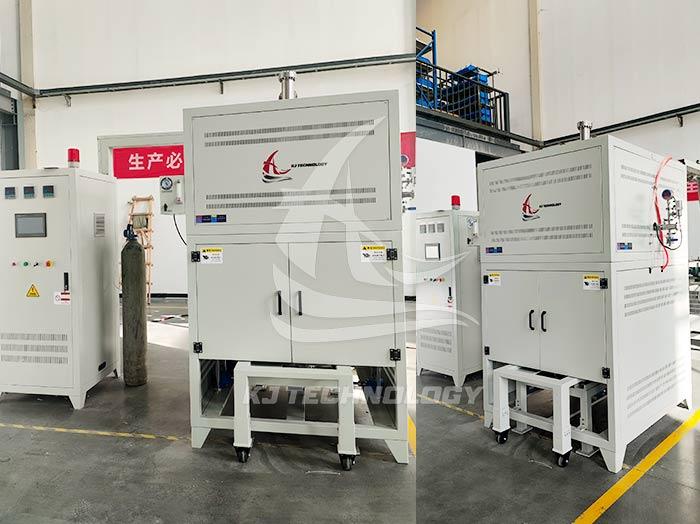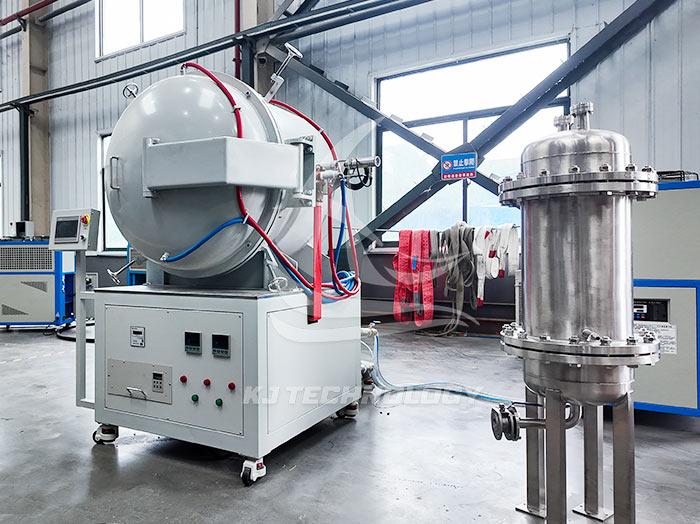What are the advantages of vacuum degreasing furnace?
 08-22-2025 Author: KJ technology
08-22-2025 Author: KJ technology
The vacuum degreasing furnace exhibits significant advantages in the material degreasing process by creating a low-pressure environment and combining it with precise temperature control, making it particularly suitable for the preparation of high-precision, high value-added materials. The following is a detailed analysis of its core advantages and specific application scenarios:
1. Avoid oxidation and pollution, ensure material purity
Inhibition of oxidation reaction in anaerobic environment
Principle: A vacuum environment (usually below 100 Pa) can significantly reduce oxygen concentration, preventing metals (such as titanium, cobalt chromium alloys), ceramics (such as silicon nitride, silicon carbide), and magnetic materials (such as neodymium iron boron) from oxidizing at high temperatures.
case
When degreasing titanium alloy orthopedic implants, a vacuum environment can prevent the formation of an oxide layer on the surface, ensuring biocompatibility.
After degreasing, neodymium iron boron permanent magnets do not require acid washing or oxygen removal, and can be directly sintered to maintain stable magnetic properties.
Reduce the introduction of impurities
Advantages: The enclosed vacuum system prevents external pollutants such as dust and moisture from entering, especially suitable for fields such as semiconductors and optical ceramics that require extremely high purity.
Data support: The carbon residue of the material after vacuum degreasing can be controlled within a certain range of values.
2. Efficient degreasing, shortening production cycle
Reduce the boiling point of organic matter and accelerate volatilization
Principle: According to the Clausius Clapeyron equation, the boiling point of organic compounds (such as paraffin and POM) significantly decreases in a vacuum environment and can be quickly removed at lower temperatures.
case
The degreasing temperature of polyoxymethylene (POM) based MIM blanks under vacuum can be reduced from 180 ℃ in traditional air furnaces to 120 ℃, and the degreasing time can be shortened.
The degreasing stage of hard alloy requires time-consuming compression.
Gradient heating and pressure pulse technology
Innovative technology:
Gradient heating: Control the heating rate in stages to avoid cracking caused by thermal stress.
Pressure pulse cleaning: alternate filling of argon gas forms a permeation suction cycle, improving degreasing efficiency.
Application scenario: When degreasing complex structured ceramics (such as turbine blades), pressure pulses can remove residual adhesive in deep holes.
3. Precise control to enhance material performance
Dimensional accuracy control
Principle: Vacuum degreasing can reduce the difference in thermal expansion of materials and avoid deformation caused by uneven removal of adhesives.
case
The size tolerance of the metal frame of the mobile phone can be controlled within a certain range after degreasing.
Ceramic cutting tools have small straightness errors after degreasing, meeting high-end machining needs.
Density and porosity optimization
Advantages: The vacuum environment promotes uniform volatilization of the binder, reduces the formation of closed pores, and increases the density of the sintered material.
Data support:
Hard alloy has high density and increased hardness after degreasing.
After degreasing, the porosity of ceramic bearing balls decreases, and their fatigue resistance is significantly better than traditional methods.
Improved interface bonding strength
Application scenario: When degreasing metal/ceramic composite materials (such as TiC Ni), vacuum environment can avoid interface oxidation and improve the bonding strength of the composite layer.
4. Energy saving and environmental protection, reducing operating costs
Low temperature degreasing reduces energy consumption
Principle: The boiling point of organic matter decreases in a vacuum environment, allowing for degreasing to be completed at lower temperatures and saving heating energy.
Data comparison:
The energy consumption of vacuum degreasing furnace is lower than that of air furnace.
The energy consumption per unit product is lower during the degreasing stage of hard alloy.
Solvent recovery and recycling
Supporting system: The wax trap and condensing device can recover more organic solvents (such as paraffin and PVA), reducing raw material costs.
Reduce the burden of exhaust gas treatment
Advantages: Vacuum degreasing is carried out in a closed system, reducing the emission of volatile organic compounds (VOCs) compared to traditional methods and meeting environmental requirements.
5. Strong adaptability, meeting diverse needs
Multi material compatibility
Supporting materials:
Metals: stainless steel, titanium alloy, cobalt chromium alloy, high-temperature alloy, etc.
Ceramics: alumina, zirconia, silicon nitride, silicon carbide, etc.
Composite materials: metal ceramics, carbon fiber reinforced ceramics, etc.
Special materials: biodegradable materials (PLA), catalytic degreasing materials (POM), etc.
Process flexibility
Optional features:
Catalytic degreasing: Accelerating the decomposition of POM by introducing an acidic atmosphere (such as nitric acid vapor).
Hydrogen degreasing: prevents oxidation of magnetic materials in a positive pressure hydrogen environment.
Staged degreasing: Design degreasing procedures for composite materials at different temperature ranges.
6. Automation and intelligence enhance production efficiency
PLC control system
Function:
Real time monitoring of temperature, pressure, vacuum degree and other parameters, automatic adjustment of process curve.
Fault diagnosis and alarm function, reducing downtime.
Case: A certain enterprise improved the degreasing yield rate through a PLC system.
Data tracing and analysis
Advantage: Record production data for each batch, support process optimization and quality traceability.
Application scenario: When degreasing aerospace components, data can be traced back to raw material batches and process parameters, meeting certification requirements.








